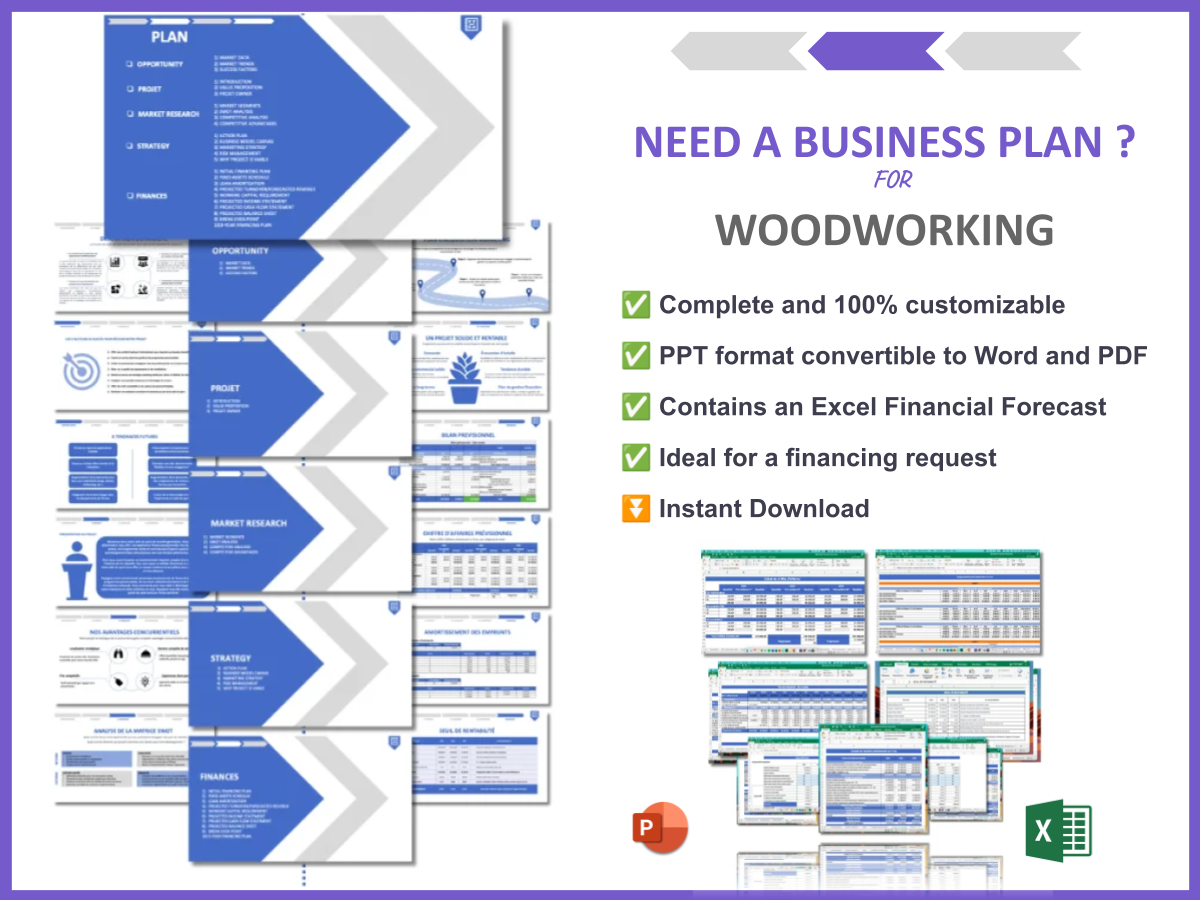Are you thinking about starting a **woodworking** business? You’re not alone! Many aspiring entrepreneurs are drawn to this craft, not just for the creative outlet but also for the potential profitability. In fact, the **woodworking industry** is booming, with a growing demand for custom pieces and unique designs. So, if you’re ready to transform your passion for woodworking into a thriving business, you’re in the right place!
Woodworking is the art of crafting functional or decorative items from wood, using various techniques and tools to shape, cut, and join wood pieces. Starting a **woodworking business** can be an enriching venture, combining creativity with craftsmanship.
In this article, we will cover:
- Understanding the basics of woodworking
- Developing a unique business idea
- Researching the market and your competition
- Creating a detailed business plan
- Choosing the right legal structure
- Marketing and branding your woodworking business
What is Woodworking and Why Start a Woodworking Business?
Woodworking is more than just a hobby; it’s a chance to turn your skills into a profitable venture. The charm of creating something from scratch, whether it’s a piece of furniture or a decorative item, draws many into this field. Here are a few reasons why you might consider starting a **woodworking business**:
- Creative Expression: Woodworking allows you to express your creativity while developing your skills.
- Market Demand: There is a significant demand for custom woodworking, as more people seek unique, handmade items.
- Profit Potential: With the right marketing and pricing strategies, woodworking can be quite lucrative.
In fact, many successful woodworking businesses report profit margins that can reach up to 30% or more, depending on the niche and market. It’s not just about making things; it’s about creating a sustainable business that brings joy to both you and your customers.
How to Start a Woodworking Business: Develop Your Unique Idea
The first step in starting your **woodworking business** is to develop a unique idea that sets you apart from the competition. This requires some brainstorming and self-reflection. Here are some points to consider:
- What woodworking skills do you possess?
- What products are you passionate about creating?
- What gaps exist in the current market that you can fill?
Consider the following popular woodworking business ideas:
| Woodworking Business Ideas | Target Market |
|---|---|
| Custom Furniture | Homeowners, Interior Designers |
| Wooden Toys | Parents, Gift Shops |
| Home Décor Items | Retailers, Online Shoppers |
By identifying your niche, you can focus your marketing efforts and build a loyal customer base. Remember, the more unique your offerings, the easier it will be to attract customers who appreciate your craftsmanship. You might want to explore eco-friendly options or specialize in custom orders to differentiate your brand.
Research the Market for Your Woodworking Business
Once you have a unique idea, the next step in starting your woodworking business is to conduct thorough market research. Understanding your target audience and the competitive landscape is crucial for success. Here’s how to get started:
- Identify Your Audience: Who will buy your products? Are they homeowners looking for custom furniture, or businesses seeking decorative pieces?
- Analyze Competitors: Look at other woodworking businesses in your area or online. What products do they offer? How do they market themselves?
- Gather Feedback: Conduct surveys or interviews with potential customers to understand their preferences and needs.
Market research can reveal invaluable insights. For example, if you discover that many customers prefer eco-friendly materials, you might want to consider that in your offerings. Here’s a simple table summarizing some research methods:
| Research Method | Description |
|---|---|
| Surveys | Gather information directly from potential customers about their preferences. |
| Competitor Analysis | Study competitors to identify successful strategies and gaps in the market. |
| Online Research | Use online tools and forums to gauge trends and customer interests in woodworking. |
By thoroughly understanding the market, you can tailor your business model and product offerings to meet customer demands effectively. This research phase is essential to ensure that your woodworking business stands out and meets the needs of your target audience.
How to Start a Woodworking Business: Choose Your Niche
Narrowing down your niche is critical for the success of your woodworking business. A specific niche allows you to focus your marketing efforts and attract a dedicated customer base. Here are some steps to help you choose your niche:
- Evaluate Your Skills: What are you best at? Do you have experience in furniture making, cabinetry, or perhaps crafting decorative pieces?
- Research Trends: Look for emerging trends in the woodworking industry. What are customers currently interested in? For example, many are looking for sustainable, handmade products.
- Consider Profitability: Some niches may be more profitable than others. Assess the market demand and potential pricing for different woodworking products.
Popular niches in woodworking include:
- Custom Furniture: Tailored pieces that meet specific customer needs.
- Wooden Toys: Eco-friendly, handcrafted toys that appeal to parents.
- Home Décor Items: Unique items that enhance interior spaces.
By carefully selecting your niche, you can position your woodworking business effectively in the market, ensuring that your products resonate with your target customers. The key is to find a balance between your passions and market demand, allowing you to thrive in your new venture.
Create a Detailed Business Plan for Your Woodworking Business
Writing a solid business plan is a crucial step in starting your woodworking business. A well-crafted business plan serves as a roadmap, guiding you through the various stages of your business journey. Here are key components to include in your plan:
- Executive Summary: A brief overview of your business, including your mission statement and the products you plan to offer.
- Market Analysis: Insights from your market research, including target customers and competitive landscape.
- Marketing Strategy: How you plan to reach and attract customers, including pricing, promotion, and distribution methods.
- Operational Plan: Details about your production process, location, and equipment needed.
- Financial Projections: Expected revenue, expenses, and profitability over the next few years.
I recommend checking out this business plan template for Woodworking. It’s super detailed and can save you a ton of time! By following a structured approach, you can ensure that your woodworking business is set up for success from the very beginning.
Decide on the Legal Structure for Your Woodworking Business
Choosing the right legal structure is an essential aspect of starting your woodworking business. The legal structure affects your taxes, liabilities, and the paperwork you’ll need to file. Here are the most common options:
| Legal Structure | Pros | Cons |
|---|---|---|
| Sole Proprietorship | Easy to set up and manage | Unlimited personal liability |
| Limited Liability Company (LLC) | Limited personal liability, flexible tax options | More paperwork and fees than a sole proprietorship |
| Corporation | Ability to raise capital through stock | Complex structure, subject to double taxation |
When deciding, consider factors like your level of risk tolerance, how much control you want, and your financial situation. Consulting with a legal professional can also help you make the best choice for your woodworking business. A solid legal foundation is vital to protect your personal assets and ensure your business operates smoothly.
Register Your Woodworking Business to Make It Official
Once you’ve chosen a legal structure for your woodworking business, the next step is to register it. This process legitimizes your business and allows you to operate legally. Here’s how to go about it:
- Choose a Business Name: Make sure your chosen name is unique and reflects your brand. Check for existing businesses with the same name in your area.
- Register with the State: Depending on your legal structure, you’ll need to file the appropriate paperwork with your state’s business office. This might include Articles of Incorporation or a DBA (Doing Business As) registration.
- Obtain Necessary Permits: Research any local permits or licenses required for operating a woodworking business in your area. This could include zoning permits or health department approvals if you’re working from home.
Registering your woodworking business is crucial for protecting your brand and ensuring compliance with local regulations. It may seem like a tedious task, but it’s an essential step toward establishing your business as a legitimate entity.
Obtain Necessary Tax Identification Numbers, Licenses, and Permits for Your Woodworking Business
After registering your business, the next important step is to obtain the necessary tax identification numbers, licenses, and permits. These are essential for legal operation and compliance. Here’s what you need to do:
- Apply for an EIN: If you plan to hire employees or operate as a corporation or partnership, you’ll need an Employer Identification Number (EIN) from the IRS.
- Sales Tax Permit: If your state requires it, obtain a sales tax permit to collect sales tax on your products. This is crucial for compliance and avoiding fines.
- Industry-Specific Licenses: Depending on your location, you may need specific licenses related to woodworking or manufacturing. Check with local authorities to ensure you meet all requirements.
Staying on top of these legal requirements is vital for your woodworking business to avoid penalties or legal issues down the line. It’s always best to consult with a legal expert or accountant to ensure you have everything in place. By doing this, you can focus on what you love—creating beautiful wood pieces!
Set Up Your Financial Management Systems for Your Woodworking Business
Establishing a solid financial management system is crucial for the success of your woodworking business. Proper financial management helps you track income, expenses, and profitability, ensuring your business remains sustainable. Here are some steps to consider:
- Choose Accounting Software: Select software that fits your needs. Popular options include QuickBooks, FreshBooks, and Wave. These tools help manage invoices, expenses, and financial reports.
- Open a Business Bank Account: Keep your personal and business finances separate. A dedicated business account simplifies tracking and tax preparation.
- Set Up a Budget: Create a budget that outlines expected income and expenses. This will help you manage cash flow and identify areas for potential savings.
Here’s a simple table outlining key financial management tasks:
| Task | Frequency | Description |
|---|---|---|
| Track Expenses | Monthly | Record all business expenses to monitor spending and identify tax deductions. |
| Review Financial Statements | Quarterly | Analyze profit and loss statements to assess the financial health of your business. |
| Prepare for Taxes | Annually | Gather all necessary documents and receipts for tax filing. |
By implementing effective financial management systems, you’ll be better equipped to make informed decisions that will benefit your woodworking business in the long run.
Establish Your Brand Identity for Your Woodworking Business
Your brand identity is how your customers perceive your woodworking business. A strong brand helps you stand out in a competitive market. Here are some key elements to consider when building your brand:
- Create a Unique Logo: Your logo should reflect the essence of your woodworking style. Consider hiring a designer or using online tools to create one that resonates with your target audience.
- Develop a Consistent Message: Ensure that your messaging across all platforms—website, social media, and promotional materials—aligns with your brand values and voice.
- Utilize Social Media: Platforms like Instagram and Pinterest are great for showcasing your woodworking projects. Regularly post high-quality images and engage with your audience to build a community around your brand.
Here are some popular platforms where you can establish your woodworking brand:
- Instagram: Share visuals of your work and connect with followers.
- Facebook: Create a business page to engage with customers and share updates.
- Pinterest: Use it to showcase your projects and drive traffic to your website.
Building a solid brand identity will help foster trust and recognition among your customers, ultimately contributing to the growth of your woodworking business. Remember, a memorable brand can make all the difference in attracting and retaining customers!
Develop a Professional Website for Your Woodworking Business
In today’s digital age, having a professional website is essential for your woodworking business. A well-designed website acts as your online storefront and helps you showcase your products, share your story, and connect with customers. Here are some key elements to include:
- Portfolio of Work: Display high-quality images of your projects to attract potential customers. Make sure to include descriptions that highlight the craftsmanship and materials used.
- About Page: Share your story, your passion for woodworking, and what sets your business apart. This personal touch can create a connection with your audience.
- Contact Information: Make it easy for customers to reach you. Include a contact form, phone number, and email address.
Here are some platforms you can use to create your website:
- Wix: User-friendly with customizable templates.
- Squarespace: Known for beautiful designs and ease of use.
- WordPress: Highly customizable, ideal for those with some technical skills.
Having a professional website not only enhances your credibility but also serves as a platform for marketing your woodworking business effectively.
Market and Advertise Your Woodworking Business
Effective marketing is essential for attracting customers to your woodworking business. Utilize a mix of online and offline strategies to reach your target audience:
- Social Media Marketing: Share your projects and engage with followers on platforms like Instagram and Facebook. Consider running targeted ads to reach a wider audience.
- Content Marketing: Start a blog on your website to share tips, tutorials, and insights about woodworking. This can help establish you as an authority in your niche and improve your SEO.
- Local Events: Participate in craft fairs, farmers’ markets, or woodworking expos to showcase your work and meet potential customers in person.
Consider the following marketing strategies to boost your visibility:
| Marketing Strategy | Description |
|---|---|
| Email Marketing | Build an email list and send newsletters with updates, promotions, and woodworking tips. |
| Influencer Collaborations | Partner with influencers in the woodworking or home decor niche to reach a larger audience. |
| Online Marketplaces | Sell your products on platforms like Etsy or Amazon Handmade to gain exposure to new customers. |
By implementing a diverse marketing strategy, you can effectively promote your woodworking business and increase your customer base.
Assemble Your Team for Your Woodworking Business
As your woodworking business grows, you may find that you need additional help to manage production, marketing, or customer service. Building a reliable team can help you scale your operations efficiently. Here are some steps to consider:
- Identify Roles: Determine what roles you need to fill. This could include skilled craftsmen, marketing specialists, or administrative support.
- Hire for Fit: Look for individuals who share your passion for woodworking and align with your business values. A good cultural fit can enhance teamwork and productivity.
- Provide Training: Invest in training for your team to ensure they are skilled in woodworking techniques and understand your business processes.
Here’s a list of potential roles to consider when building your team:
- Woodworkers: Skilled individuals who can help with production.
- Marketing Specialists: Experts who can handle advertising and social media.
- Customer Service Representatives: Individuals who can manage inquiries and ensure customer satisfaction.
Assembling a competent team will allow you to focus on growing your woodworking business while ensuring that your operations run smoothly.
Conclusion
Starting a woodworking business can be an incredibly rewarding journey, allowing you to blend creativity with entrepreneurship. By following the steps outlined in this guide—from developing your unique idea to assembling your team—you can lay a solid foundation for success. Remember to stay adaptable and continuously seek opportunities to learn and grow.
To further enhance your knowledge, I encourage you to explore additional resources. Check out our article on how to create a SWOT Analysis for Woodworking to evaluate your business’s strengths and weaknesses. Also, don’t miss our guide on How to Build a Woodworking Marketing Plan? With Example to help you effectively promote your products.
With passion, dedication, and the right strategies, your woodworking business can thrive and bring joy to both you and your customers!
FAQ
- What do I need to start a woodworking business?
To start a woodworking business, you need a solid business plan, woodworking tools, a workspace, and the necessary licenses and permits. Additionally, having a marketing strategy and a professional website can help you attract customers. - How much money do I need to start a woodworking business?
The startup costs for a woodworking business can vary widely, depending on your niche, equipment, and materials. On average, initial costs can range from a few hundred to several thousand dollars. - What types of woodworking businesses are most profitable?
Profitable woodworking businesses often include custom furniture making, cabinetry, and crafting unique home décor items. Custom woodworking and eco-friendly products are particularly in demand. - Do I need a business license for woodworking?
Yes, obtaining a business license is typically necessary for operating a woodworking business. The specific requirements may vary based on your location, so check with local authorities. - How can I market my woodworking business?
You can market your woodworking business through social media, a professional website, email marketing, and participation in local events. Content marketing, such as blogging about woodworking tips, can also attract potential customers. - What woodworking tools do I need to start?
Essential tools for a woodworking business include a table saw, miter saw, hand tools, clamps, and measuring tools. The specific tools will depend on the types of products you plan to create. - How do I price my woodworking products?
To price your woodworking products, consider your costs, including materials and labor, as well as market research on similar items. Aim for a price that reflects your craftsmanship while remaining competitive. - Can I run a woodworking business from home?
Yes, many woodworking businesses operate from home workshops. However, ensure that you comply with local zoning laws and regulations regarding home-based businesses. - What are common challenges in the woodworking business?
Common challenges include managing production costs, competing with larger manufacturers, and finding reliable suppliers. Staying updated on industry trends can help you navigate these challenges. - How can I improve my woodworking skills?
Improving your woodworking skills can be achieved through practice, taking classes, and watching online tutorials. Joining woodworking communities can also provide valuable tips and support.







